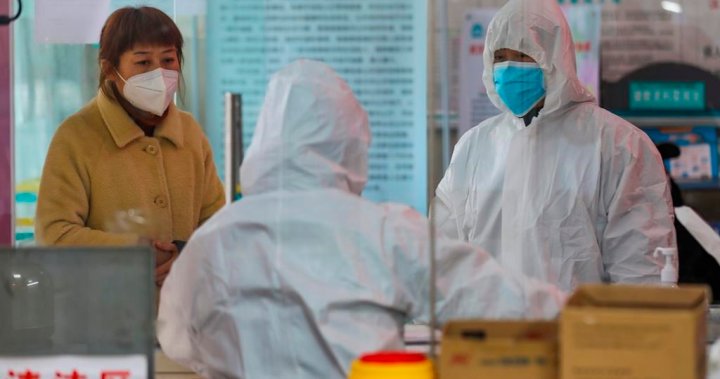Here is a blog post about the Wuhan coronavirus; important graphics did not copy over so see link for them:
Fair use cited
Saturday, February 15, 2020
The Covid19 death rate is much higher than 2%
The Covid19 death rate is much higher than 2%
I understand why Moldbug wanted to
write a post on the coronavirus. As usual, Moldbug was ahead of the curve. The reason is that he reads sources that other people don’t read. If you read the same as everyone else, you think the same as everyone else. This is the main (respectable) reason I’m on twitter, (other than the shitposting which is like terrible cheap carbs of reading material). 95% of it is garbage, but the remaining 5% is stuff you just don’t find anywhere else.
And what Moldbug, and MorlockP, and Loki Julianus and some others have figured out is that there’s a decent chance that this is the start of the shit hitting the fan, but nobody in the west seems much concerned yet. It’s a fascinating insight into how people respond to gradually unfolding disaster. We expect disaster to strike out of the blue. One day, the Soviets nuke us, or an asteroid strikes. Or, failing that, we expect to see a fairly rapid and linear growth of things getting worse, like in a disaster movie where the plot has to unfold in a predictable manner to all be wrapped up in 90 minutes.
What our instincts don’t work well for, however, is exponential growth. It just doesn’t fit people’s casual intuitions about what’s going to happen. The probably mythical story about the inventor of chess is that he asked to be paid as a reward by the king in a grain of rice for the first square, two grains for the second square, four for the third square, and so on. Of course, the point of the story is that the king was an idiot and by the end figured out he couldn’t possible pay. Ha ha ha. Nobody would be that dumb.
Well, here’s some grains of rice accumulating.
If you take the number of coronavirus cases reported, it’s close to an exponential curve. Not quite, however. If you plot things on a log scale, you can see the rate of increase in reported cases slowing down.
By eyeballing the log scale graph, you can see that things started to decline starting around Jan 30th. If you run a regression of log number of cases on number of days since outbreak, from Jan 30th until February 13th, you get a coefficient on time of 0.126, or 12.6% growth per day. If you want to be conservative, and just use the February 5th – 11th data, excluding the big jump on February 12th when they changed reporting standards, you still get an average growth of 0.078, or 7.8% growth per day. The R2 of this regression is 0.98, by the way, so this is a shockingly good fit. If you use the whole period, you get a whopping 19.9% average growth per day. And even with the slowdown, the R2 is still over 0.92.
Since these are only rough data, because God knows how many unreported cases there are, suppose the number of cases is growing about 10% per day. There’s a rule of thumb for turning growth rates into doubling times called the rule of 72. Divide 72 by the growth rate and you get a decent estimate of the doubling time. So in this case, 72/10 = 7.2. In other words, on current trends we expect the number of cases to double every week. Even at the low rate of 7.8%, the number of cases is expected to double in around 9 days. We won’t use this rule exactly, but it’s pretty good for thinking about intuition.
And this causes all sorts of weird mistakes. One, which I think is underappreciated by most people, is wildly distorted estimates of the death rate.
The number that keeps getting currently quoted in the press is a death rate of around 2%. As of February 13th, there have been 1,384 deaths out of 64,473 cases, according to worldometer. This gives a death rate of 2.15%. Which sounds pretty encouraging. It seems like you have to get very unlucky to actually die from it.
But the strange thing is, there’s another, smaller set of people talking about a death rate of 16%. What’s that? Well, it’s the ratio of deaths (1,384) to
closed cases (8,566), or 16.16%.
Now, you might look at it be concerned about the definition of closed cases. Maybe they’re just very reluctant to declare someone cured, so there’s lowball numbers here (whereas they’re less reluctant to declare someone dead). Many of the diagnosed will eventually recover, but it takes ages to classify them as healthy again. So no big deal! 16% is too high, and the true number will be much lower.
Well, here’s a pretty strong reason to prefer the ratio using closed cases. From the descriptions you read about the progression of cases in places like Hong Kong, the disease generally takes 2-3 weeks from diagnosis to actually kill you.
Why is this a big deal?
Because the number of cases is growing at around 8-10% a day. And as long as that holds, the number of deaths will always be lagging the total number of cases in the growth phase. The death rate actually ought to be compared with the number of cases from 2-3 weeks earlier, because that’s the number of people who could have reasonably died by this point. It’s also the expectation of the fraction of currently alive new cases who will eventually die. Again, this may seem like pedantry. Except that the number of cases is growing 8% per day!
Let’s start with lower bounds. Assume that average growth in cases is conservatively 7.8%. Also, let’s assume the disease kills you quickly, on average in two weeks (which is optimistic for the purposes of our estimated death rate being on the low side). In this case, the number of cases in the denominator is too high by a factor of e^(14*0.078) = 2.98. So the true death rate will end up being 2.15*2.98 = 6.42%
If it takes 2.5 weeks on average to kill you, the death rate will end up being 2.15* e^(17.5*0.078) = 8.43%.
But we’re using a pretty conservative estimate of growth rates. Suppose you take dates since February 5th, but include the increase in cases on Feb 12th and 13th. Then the average growth rate is 9.75%. Add a 2.5 week average time to death, and the death rate is actually 2.15*e^(17.5*0.0975) = 11.85%. If the disease takes three weeks on average to kill you, the true death rate is 16.67%. Which sounds very close to the death rate from closed cases. Add in growth rates from the earlier period, and the numbers get even higher.
Plug in your own assumptions or data fiddling, and the answers fall right out. There’s obviously big standard errors on this stuff. But one thing is pretty clear. There is more than enough evidence at this point, no matter how you cut it, that the overall death rate is going to be a lot higher than 2%. I’m betting on 5-10%. You ought to be making plans accordingly.
This doesn’t tell you about the rate of transmission, of course, either in China or the US. Maybe we’ll lucky, and it won’t turn into a pandemic outside China. Want to bet on that?
The good news from all this is that most people don’t care about China, haven’t read reports of any major outbreak in the US, and so aren’t really concerned. Which means that if you
do think that there’s a non-trivial chance that the porridge may totally hit the propeller in a month or two, it’s still relatively easy to buy at least several months of storable food supplies. Amazon will still deliver them in a few days. Prices will be the same as normal. The guy delivering them has a very low chance of having the coronavirus. Maybe those things will still be true in three months. Maybe they won’t.
For the sake of a few hundred bucks, you’d be mad not to. You want to have a viable strategy in place to be able to not leave your house for an extended period of time. This is just basic finance. You want to hedge left tail outcomes, especially if the outcome is a catastrophe, and the cost of hedging it is very cheap. Surely everyone who understands finance is doing this, right?
Ha ha, no, of course they’re not. We’ve ignored the largest reason
smart people don’t do this stuff. It’s unfashionable. It’s for loser, tin foil prepper types. Do you really want to be doing this stuff? Tell your friends you’ve started buying large quantities of canned food and you think they should too, and they’ll look at you like you’re a conspiracy theory loon. They’ll have a good laugh.
So did the King, when they were only up to the fourth chess square.
Posted by Shylock Holmes at
10:00 AM
=============







